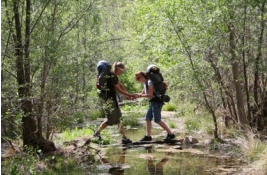Sycamore Canyon
 by Matthew J. Nelson
by Matthew J. Nelson
Arizona is filled with natural wonders. Among the most sublime and spectacular is Sycamore Canyon, a seldom visited chasm just north of the US/Mexico border.
After hiking for a mile through grasslands and oak woodland, the trail enters the canyon and almost instantly it’s easy to forget you’re in Arizona. Sycamore Canyon is home to about 20 plants and animals that are found nowhere else in the state. This lush riparian corridor is a migratory route for exotic species wandering up from the jungles and mountains of Mexico and Central and South America. A primitive trail follows the canyon downstream, and crosses the creek numerous times.
About a mile and a half down the trail the canyon becomes narrow and drops off into a series of large pools. Unless you’re feeling adventurous and don’t mind getting completely soaked, you can bypass this obstacle by hiking up a few switchbacks just east of the creek. Hike immediately down to the water and you’ll arrive at one of the best lunch spots in the entire canyon. Deep pools beckon you to jump in and abundant shade trees offer an ideal spot for a mid-morning siesta. If you want to keep your hike on the light side, turn around here.
But chances are that you’ll be so enamored by Sycamore Canyon’s magic that you’ll want to continue on. The trail continues along the creek, past towering rock spires and finely sculpted cliffs. The sound of trickling water will draw you deeper and deeper in; the further you go, the better it gets.
Water in Sycamore Canyon runs all year long, but summer monsoons bring renewed life to the entire ecosystem. After the deluge the canyon fills with butterflies, birds and flowers. If you’re there in the evening, the canyon walls become an amphitheater for red spotted toads as their summertime mating rituals commence.
It’s only a two-hour drive south of Tucson, but hiking in Sycamore Canyon is as exotic as taking a trek through the jungles of Chiapas (minus the pyramids, of course). Elegant Trogons, brown vine snakes and jaguars have been documented in this desert oasis. Walk quietly and you may be lucky enough to see one.
Making Your Escape
Take I-19 south to Ruby Road. Exit Ruby Road (Hwy. 289) and drive west for 14 miles. At the junction to Peña Blanca Lake, turn left toward Arivaca (FS 39). Ten miles along this winding dirt road will deliver you to a thick forest of oak trees known as Bear Valley. When the road curves to the right, look for the Sycamore Canyon sign pointing to the left. The parking and picnic area is immediately visible. The trail begins just south of the two metal posts at the south end of the picnic area. n
Matthew J. Nelson is a local outdoor educator, guide and conservationist.
Category: RECREATION




